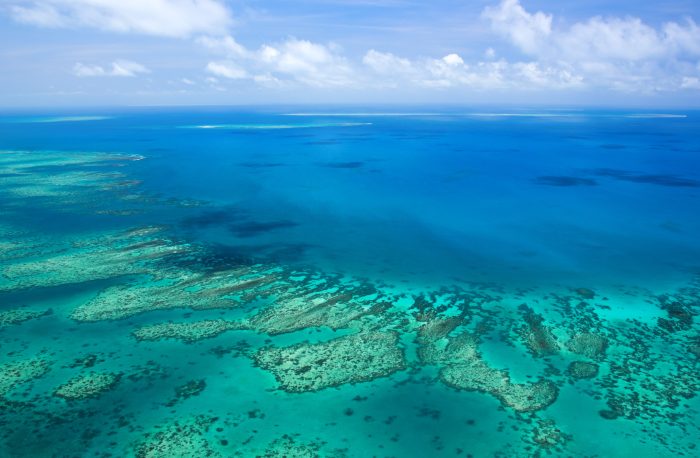Written by Laure Poncet
Meet Lara Richards, a PhD researcher at Monash University and the ARC Centre of Excellence for Climate Extremes, whose work explores how meteorology influences coral bleaching on the Great Barrier Reef.
In her latest study, Lara and her co-authors reveal that a collapse in trade winds played a crucial role in the 2022 mass bleaching event. The Centre recently spoke to Lara about her PhD journey and the findings of her latest study.

Can you share a bit about yourself, your background, and your research area?
I completed my undergraduate studies at Monash University, majoring in atmospheric science. I had initially planned to become a forecaster at the Bureau of Meteorology after my studies, but after enjoying my atmospheric dynamics classes, I decided to apply for an honours year instead.
My honours research focused on northern Australian meteorology. I spent most of my project understanding the wind patterns that control the location of strong moisture gradients known as drylines. Shortly after finishing my honours, I was offered a PhD project to better understand the meteorology during coral bleaching events on the Great Barrier Reef (GBR).
In my project, I study the evolution of local and large-scale meteorology throughout bleaching events. More importantly, I try to understand why and how these ‘bleaching’ weather patterns form and why they eventually disappear.
What sparked your interest in this topic?
Along with weather and climate sciences, I’ve always enjoyed ecology and conservation biology and actually completed part of my science undergraduate studies in that field. So, this project was a really exciting way of connecting both my atmosphere and ecology backgrounds. I also really enjoyed working with wind patterns during my honours project so it was an opportunity to apply what I had learned to a topic people really care about.
You recently published a paper looking at the meteorology during the 2022 bleaching event over the GBR. What were your main findings?
In our new study, we show that local meteorology is an important driver of GBR coral bleaching. We found that the 2022 bleaching event, which occurred under La Nina conditions, was linked to the breakdown of the trade winds.
Trade winds are persistent south-easterly winds that cover the entire GBR. We found that when they collapse, the winds over the GBR become weak or northerly, forcing warm and moist air over the reef. This influx of warm and moist air inhibits latent heat flux and evaporation at the ocean surface, which is an important cooling mechanism, allowing for heat to build in the upper ocean.
At the same time, the weaker winds combined with the warm and moist boundary layer help reduce the local cloud cover over the GBR allowing more solar radiation to penetrate into the ocean. We found that once the trade winds re-established, the ocean rapidly cooled back to seasonal norms.
Many studies have tried to link spikes in ocean temperature and the resulting bleaching events to El Niño. By looking at 2022 in particular, or the first bleaching event during a La Niña phase, we were able to show that the local meteorology is an important driver of GBR coral bleaching and that El Niño alone does not cause bleaching events as bleaching can and does occur in both El Niño and La Niña phases.

How do your findings contribute to the protection of the GBR?
Understanding the local meteorology and why these bleaching conditions form is an important step for mitigation strategies. For example marine cloud brightening and fogging is being trialed on the GBR by the Reef Restoration and Adaptation Program (RRAP). These strategies aim to reduce the amount of incoming solar radiation entering the ocean to potentially reduce coral bleaching. If we can forecast when the trade winds will break down, this provides groups like RRAP time to prepare and deploy their marine cloud brightening strategy.
It is important to highlight however, that the main impacts on the GBR are rising ocean temperatures due to climate change, so unfortunately there is no quick fix for preventing mass bleaching events. Our best chances for saving the GBR are through continued climate action and proactive management strategies such as reducing local stressors (invasive species management, reducing environmental pollutants, etc.).
What do you like most about doing your research?
I always liked research and writing essays in my undergraduate studies, but doing my own research is very different. I enjoy filling the current gaps in the literature and adding a new perspective to the existing research as many studies come from those with an oceanography or coral ecology background. Since I’m trying to address coral bleaching from an atmospheric perspective, it’s really exciting to connect the atmosphere, ocean and coral reef fields through my research.
I also really enjoyed my visits to the reef during my project. As my PhD is funded by the RRAP, I was lucky enough to be involved in their 2023 and 2024 summer field campaigns for their marine cloud brightening trials. In 2023, I spent 3 weeks at the Heron Island research station assisting with some cloud and precipitation monitoring equipment, while in 2024, I spent 10 days at Hamilton Island, assisting with the daily weather forecasting and briefings during the field campaign. Being able to visit the sites I study has been extremely beneficial to my research.
What are your next steps?
I’m drafting my second paper and trying to see if what I learned from the 2022 case study applies to the other seven mass bleaching events. I’d like to understand if there are influences from larger weather patterns like the Australian monsoon and tropical cyclones. The last phase of my PhD will look more into the trade winds and why they collapse, remain collapsed and how they re-establish. We have some good ideas from the 2022 case study, but we need to look at more events to see what other processes are involved.
